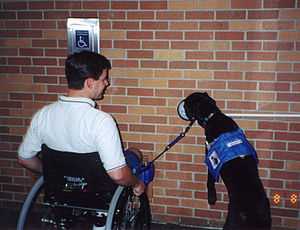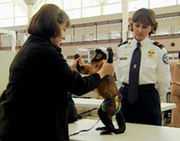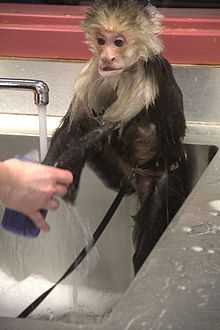Service animal

Service animals are animals that have been trained to perform tasks that assist people with disabilities. Service animals may also be referred to as assistance animals, assist animals, support animals, or helper animals depending on the country and the animal's function.
Dogs are the most common service animals, assisting people in many different ways since at least 1927.[1] Other animals such as monkeys, birds and horses have also been documented.
In places of public accommodation in the United States, only dogs (and in some cases miniature horses) are legally considered service animals.[2] There is a broader definition for assistance animals under the US Fair Housing Act as well as a broader definition for service animals under the US Air Carrier Access Act.[2]
Definitions
The international assistance animal community has categorized three types of assistance animals:[3]
- Guide animal—to guide the blind
- Hearing animal—to signal the hearing impaired
- Service animal—to do work for persons with disabilities other than blindness or deafness.
Access
Despite regulations or rules that deny access to animals in restaurants and other public places, in many countries, guide dogs and other types of assistance dogs are protected by law, and therefore may accompany their handlers most places that are open to the public. Laws and regulations vary worldwide:
- In the United States, the Americans with Disabilities Act of 1990 prohibits any business, government agency, or other organization that provides access to the general public from barring guide dogs. However, religious organizations are not required to provide such access. Current federal regulations define "service animal" for ADA purposes to exclude all species of animals other than domestic dogs and miniature horses.[4] Other laws, though, still provide broader definitions in other areas. For instance, the Department of Transportation's regulations enacting the Air Carrier Access Act permit "dogs and other service animals" to accompany passengers on commercial airlines.[5] The Fair Housing Act also requires housing providers to permit service animals (including comfort and emotional support animals) without species restrictions in housing.[6]
- In most South American countries and Mexico, guide dog access depends solely upon the goodwill of the owner or manager. In more tourist-heavy areas, guide dogs are generally welcomed without problems. In Brazil, however, a 2006 federal decree[7] requires allowance of guide dogs in all public and open to public places. The Brasília Metro has developed a program which trains guide dogs to ride it.
- In Europe, the situation varies by location. Some countries have laws that govern the entire country and sometimes the decision is left up to the respective regions.
- In Australia, the Disability Discrimination Act 1992 protects all assistance dog handlers. Current laws may not ensure that assistance dog users can always have their service animals present in all situations.[8] Each state and territory has its own laws, which mainly pertain to guide dogs. Queensland has introduced the Guide Hearing and Assistance Dog Act 2009[9] that covers all certified assistance dogs.
- In Canada, guide dogs along with other service animals are allowed anywhere that the general public is allowed, as long as the owner is in control of them. Fines for denying a service animal access can be up to $3000 in Alberta, Canada.[10]
- In South Korea, it is illegal to deny access to guide dogs in any areas that are open to the public. Violators are fined for no more than 2 million won.[11]
Animals for individual assistance
Many service animals may be trained to perform tasks to help their disabled partners live independent lives. Such animals include:
- Seizure sensing dogs, trained to sense epileptic seizures in their partner.
- Capuchin monkeys, which can be trained to perform manual tasks such as grasping items, operating knobs and switches, and turning the pages of a book.[12]
- Miniature horses, which can be trained to guide the blind,[13] to pull wheelchairs, or as support for persons with Parkinson's disease. Miniature horses may be chosen by people whose religion considers dogs to be unclean or who have serious allergies to dogs.
Helper monkey

A helper monkey is a type of assistance animal, similar to an assistance dog, that is specially trained to help people with quadriplegia, severe spinal cord injuries, or other mobility impairments.

Helper monkeys are usually trained in schools by private organizations, taking 7 years to train on average, and are able to serve 25–30 years (two to three times longer than a guide dog).[14]
After being socialized in a human home as infants, the monkeys undergo extensive training before being placed with an individual needing assistance. Around the house, the monkeys assist in daily living by doing tasks including microwaving food, washing their human's face, and opening drink bottles.
Debbie Leahy, manager of captive wildlife protection for the Humane Society of the United States, says that monkeys are not legitimate service animals and that their training sometimes involves abuse.[15]
See also
- Emotional support animal—an animal that makes the owner feel better emotionally
- Animal-assisted therapy-therapy that uses contact with animals to improve a patient’s social, emotional, or cognitive functioning
- Working animal—an animal that is trained to engage in productive tasks
References
- ↑ Harrison Eustis, Dorothy (November 5, 1927). "The Seeing Eye". Saturday Evening Post: 43.
- ↑ 2.0 2.1 Revised ADA Requirements: Service Animals. US Department of Justice. 12 July 2011. Accessed 28 January 2014
- ↑ International Association of Assistance Dog Partners Retrieved on October 17, 2007.
- ↑ "Service Animals". Civil Rights Division. US Department of Justice. Retrieved 24 October 2013.
- ↑ "14 CFR Part 382 Nondiscrimination on the Basis of Disability in Air Travel". Department of Transportation. Retrieved 3 December 2013.
- ↑ "Fair Housing Information Sheet # 6: Right to Emotional Support Animals in 'No Pet' Housing". Bazelon Center for Mental Health Law. Retrieved 24 October 2013.
- ↑ "Decreto nº 5904". Planalto.gov.br. 2006-09-22. Retrieved 2012-06-27.
- ↑ Paul Harpur, ‘The Convention on the Rights of Persons with Disabilities and Australian anti-discrimination laws: What Happened to the Legal Protections for People Using Guide or Assistance Dogs?’ (2010) 29 University of Tasmania Law Review 1, 49-77.
- ↑ https://www.legislation.qld.gov.au/LEGISLTN/ACTS/2009/09AC004.pdf
- ↑ "Canada – Alberta – Service Dogs Act". Animallaw.info. 2009-01-01. Retrieved 2012-06-27.
- ↑ http://www.funpawcare.com/2015/01/06/service-dogs-many-asian-countries-setting-a-good-example/
- ↑ Helping Hands Retrieved on October 17, 2007.
- ↑ Guide Horse Retrieved on October 17, 2007.
- ↑ "Monkey Helpers Lend a 'Helping Hand'". Retrieved August 14, 2006.
- ↑ Leahy, Debbie (2 April 2013). Why Justin Bieber Shouldn't Have a Monkey. National Geographic News. Interview with Marc Silver. Retrieved 23 April 2013.
External links
- The Animal Legal and Historical Center at Michigan State University College of Law
- "Creature Comforts", by Rebecca Skloot, New York Times, December 31, 2008. Discusses the many types of service animals.
- Capuchin monkey helpers MSNBC Feature
- Allowed on Airplanes Transport Security Administration